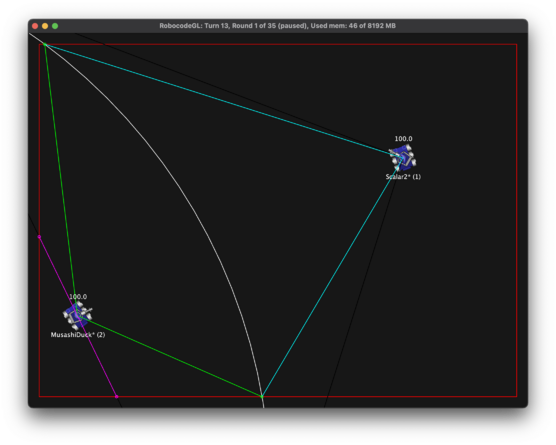Difference between revisions of "Maximum Escape Angle/Precise Positional/Non-Iterative"
m (fix) |
m (Update HighRes Illustration Graphics) |
||
| (3 intermediate revisions by the same user not shown) | |||
| Line 1: | Line 1: | ||
| − | + | {{Stub}} | |
| − | + | [[Image:Non-iterative PPMEA.png|frameless|Illustration of non-iterative PPMEA.|right|middle|556x445px]] | |
| − | + | '''Non-iterative PPMEA''' is a mathematical definition of [[PPMEA]] along with an algorithm to calculate it. | |
| − | + | == Definition == | |
| − | + | Consider the [[Escape Envelope]] ignoring heading & velocity changing rules. Without walls, this area is essentially the area of [[Escape Circle]], in which PPMEA equals to traditional MEA. And with walls, it is the intersection of the area of the escape circle and the battle field (points reachable by a robot considering only walls). | |
| − | + | Then PPMEA can be defined as the angles between the line-of-sight and each of the pair of rays with maximum angle between them, where the rays are from firer to points in the [[Escape Envelope]] described above. | |
| − | + | == Algorithm == | |
| − | The | + | The rays with the property described above can either by tangent rays to the circumference part of the outline of the escape envelope described above (in which PPMEA = Traditional MEA), or rays to the vertexes of the area (in which MEA is affected by walls). |
| − | + | With this in mind, to find PPMEA, take a collection of rays from firer to the intersections of the escape circle and the walls, along with the tangent rays to the escape circle whenever the intersection is within the battle field. The PPMEAs can be calculated by taking the maximums of the angles formed by one of the rays and line of sight, in either direction. | |
| + | |||
| + | == See also == | ||
| + | * [[Escape Circle]] | ||
Latest revision as of 13:30, 22 August 2021
| This article is a stub. You can help RoboWiki by expanding it. |
Non-iterative PPMEA is a mathematical definition of PPMEA along with an algorithm to calculate it.
Definition
Consider the Escape Envelope ignoring heading & velocity changing rules. Without walls, this area is essentially the area of Escape Circle, in which PPMEA equals to traditional MEA. And with walls, it is the intersection of the area of the escape circle and the battle field (points reachable by a robot considering only walls).
Then PPMEA can be defined as the angles between the line-of-sight and each of the pair of rays with maximum angle between them, where the rays are from firer to points in the Escape Envelope described above.
Algorithm
The rays with the property described above can either by tangent rays to the circumference part of the outline of the escape envelope described above (in which PPMEA = Traditional MEA), or rays to the vertexes of the area (in which MEA is affected by walls).
With this in mind, to find PPMEA, take a collection of rays from firer to the intersections of the escape circle and the walls, along with the tangent rays to the escape circle whenever the intersection is within the battle field. The PPMEAs can be calculated by taking the maximums of the angles formed by one of the rays and line of sight, in either direction.
